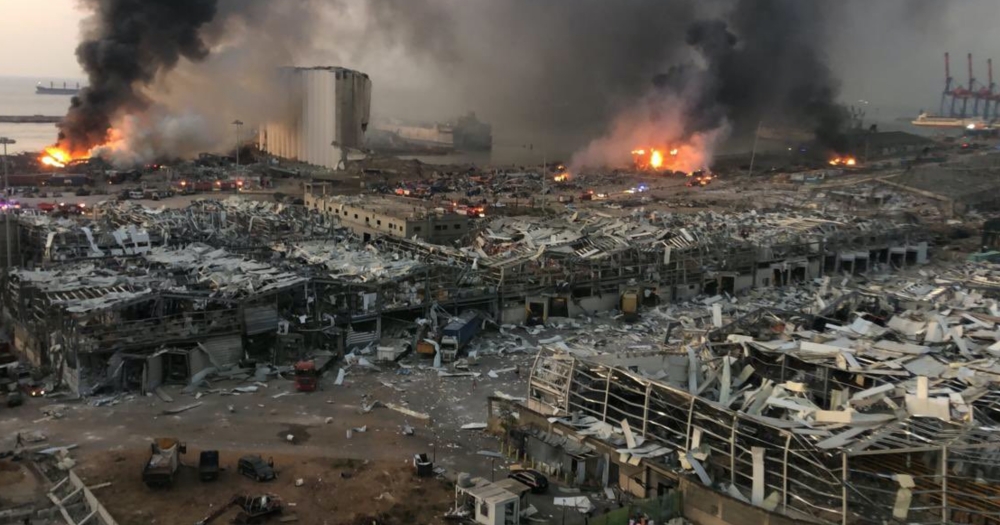A huge explosion sent shock waves across Beirut, Lebanon on Tuesday (Aug. 4).
At least 100 people were killed and more than 4,000 were wounded as of today (Aug. 5), reported Lebanon news The Daily Star.
Officials say they expect the death toll to rise further as emergency workers continue to dig through the rubble.
Here is some footage of the explosion:
What happened?
According to BBC, the explosion occurred just after 3pm GMT (11pm Singapore time) on Aug. 4.
It began with a fire at the port of Beirut, which subsequently exploded.
Major downtown streets in the city were full of debris and damaged vehicles, reported The New York Times.
A BBC journalist at the explosion scene reported "dead bodies and severe damage".
The blast was so powerful, it could be felt about 160km away in Cyprus.
How bad is the damage?
Beirut’s mayor, Jamal Itani, told Reuters while inspecting the incident's damage: "It’s like a war zone. I’m speechless."
He also estimated that the damage would cost billions of dollars.
Pictures and videos of the explosion's aftermath have been posted on social media:
2/ Terrifying footage of street scenes in #Beirut. pic.twitter.com/8t7L7kcRcX
— Farnaz Fassihi (@farnazfassihi) August 4, 2020
Some pictures from inside Beirut's mangled port today. pic.twitter.com/ccf3drv3QX
— Timour Azhari (@timourazhari) August 4, 2020
This is devastating. Lebanon was already spiralling, in the midst of a political and currency crisis with accelerating COVID-19 cases. People were going hungry - and that's the city's largest grain elevator right there. pic.twitter.com/HiGPBhLGVh
— Tobias Schneider (@tobiaschneider) August 4, 2020
More scenes of devastation from the surrounding area near Beirut's port:
— Ashleigh Stewart (@Ash_Stewart_) August 5, 2020
📸: @Reuters / Aziz Taher pic.twitter.com/bOVhTOxb7K
Drone pictures from the explosion in Beirut, you can clearly see the crater. At least 75m wide. pic.twitter.com/5UqRSHee17
— OSINTtechnical (@Osinttechnical) August 5, 2020
Our condolences, prayers and support to all those affected by the explosion in Beirut, Lebanon yesterday. 🙏🙏 pic.twitter.com/Syf6cGmhNC
— MR KEMS (@mr_kems1) August 5, 2020
Smoldering wreckage is seen a day after a powerful warehouse explosion shook Lebanon’s capital, killing scores of people https://t.co/t3St2rGDZt pic.twitter.com/ThktL5wUOi
— Reuters (@Reuters) August 5, 2020
The explosion has sparked concerns over how Lebanon will continue to import its vital goods as its main port has been destroyed.
For now, the Tripoli Port will take over as the main port.
Around 80 per cent of Lebanon’s wheat supply is imported, according to The Associated Press (AP).
Lebanon's minister of economy and trade, Raoul Nehme, said that all the wheat stored at the facility had been contaminated and could no longer be used due to the explosion.
However, he added Lebanon had enough wheat for its "immediate needs", reported AP.
The blast had also destroyed apartment buildings and houses, which left a lot of people homeless.
Beirut governor Marwan Abboud told MTV news that around 200,000 people have been left homeless due to the explosion.
He added that agencies are working to provide shelter, food and water.
Abboud to MTV: Damage is huge in #Beirut and its value ranges between 3 to 5 billion; around 200-250 thousand people have become homeless, and we are working on their relief by providing food, water, and housing
— MTV English News (@MTVEnglishNews) August 5, 2020
What caused it?
Although the cause of the blast has yet to be confirmed, officials are linking it to 2,750 tonnes of ammonium nitrate that have been stored in a warehouse at the port since 2014.
Ammonium nitrate is commonly used as an agricultural fertiliser or as a bomb.
It is highly explosive when it comes into contact with fire.
When it explodes, it can release toxic gases, such as nitrogen oxides and ammonia gas.
Ammonium nitrate has also been the cause of many industrial explosions over the years.
These include an explosion in Texas in 2013 that killed 15 people, and another in Toulouse, France in 2001 that killed 31 people.
U.S. President Donald Trump suggested that the explosion seemed to be a bomb "of some kind", citing his generals.
Defence officials however told CNN that there was no indication that the explosion was an attack.
According to Reuters, Lebanon’s Prime Minister Hassan Diab said that those responsible for the explosion would pay the price.
"I promise you that this catastrophe will not pass without accountability. [...] Those responsible will pay the price.
Facts about this dangerous warehouse that has been there since 2014 will be announced and I will not preempt the investigations."
Other countries providing aid
An Al Jazeera senior correspondent reported that Lebanon's Health Minister has appealed for international assistance as medical goods, which were being held near to the site of the blast, were destroyed in the explosion.
Health minister appeals for intl assistance - medical supplies stored at a warehouse close to the #Beirut port have been destroyed -
— Zeina Khodr (@ZeinakhodrAljaz) August 5, 2020
Neighbouring countries, including Jordan, Egypt, Israel and Kuwait have been providing aid to Beirut.
Meanwhile, France is sending two planes to the city. According to MTV News, the planes will carry a team of civil security— 55 people and 15 tons of equipment— and a mobile health centre that includes six tons of equipment.
This will allow the treatment of 500 wounded people.
Other countries that are ready to offer help include Russia, Greece, Denmark and the Czech Republic.
Related articles
Top image from Tobias Scheneider/Twitter.
If you like what you read, follow us on Facebook, Instagram, Twitter and Telegram to get the latest updates.
